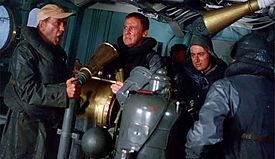The Caine Mutiny (1954 film)
The Caine Mutiny is a 1954 American military trial film directed by Edward Dmytryk, produced by Stanley Kramer, and starring Humphrey Bogart, José Ferrer, Van Johnson, Robert Francis, and Fred MacMurray.
Set in the Pacific theatre of World War II, the film depicts the events on board a U.S. Navy destroyer-minesweeper and the subsequent court-martial of its executive officer for mutiny.
Under Greenwald's relentless cross-examination, Queeg exhibits odd behavior on the stand, including his habit of rolling two steel balls in his hand symbolizing his mental instability, and Maryk is acquitted.
A drunken Greenwald arrives and berates all the officers for not appreciating Queeg's long service and failing to give him the support he asked for, instead of deriding him as an incompetent.
Greenwald claims their mistreatment of Queeg, who had been suffering from "battle fatigue" from his previous combat service in the Atlantic, caused the captain to ultimately become indecisive during the typhoon.
Keith, now married to his girlfriend May Wynn, is promoted to lieutenant (junior grade), and assigned to a new Sumner-class destroyer commanded by now-Commander De Vriess, his first captain in the Caine.
Herman Wouk had already adapted his novel as a stage play, The Caine Mutiny Court-Martial, which premiered on Broadway in January 1954 and ran for more than a year.
[7] Independent producer Stanley Kramer "mollified the Navy" by modifying the Queeg characterization to make him less of a madman, as portrayed by Wouk, and more a victim of battle fatigue.
The Zane was retired shortly after the war, and the Southard was scuttled in October 1945 after running aground in Okinawa with Wouk serving as Executive Officer.
One of the primary inspirations for the book and the movie came from Wouk's experience as second in command of the Southard when she ran aground in Okinawa as a result of Typhoon Ida in September 1945.
[19] The Navy was initially uncomfortable with both the portrayal of a mentally unbalanced man as the captain of one of its ships and the word "mutiny" in the film's title.
After Stanley Roberts' shooting script was completed and approved by the Navy after 15 months of negotiations, the Department agreed to cooperate with Columbia Pictures by providing access to its ships, planes, combat boats, Pearl Harbor, the port of San Francisco, and Naval Station Treasure Island for filming.
The main title theme, The Caine Mutiny March, was included in RCA Victor's collection of classic Bogart film scores, recorded by Charles Gerhardt and the National Philharmonic Orchestra.
According to Wouk, "Columbia head Harry Cohn looked into the matter, called me back, and said in his tough gravelly voice, 'I've got you beat on the legalities, but I've listened to the record and it's no goddamn good, so I'm yanking it.
[11] The film got a major pre-release boost three weeks before its premiere when Bogart as Queeg appeared on the cover of the June 7, 1954 issue of Time magazine.
"[27] Director Edward Dmytryk felt The Caine Mutiny could have been better than it was and should have been three and a half to four hours long to fully portray all the characters and complex story, but Columbia's Cohn insisted on a two-hour limit.
[8] Reviewing the film in The New York Times, Bosley Crowther wrote that the job of condensing Wouk's novel to two hours had been achieved "with clarity and vigor, on the whole."
His reservations concerned the studio's attempt to "cram" in "more of the novel than was required", such as the "completely extraneous" love affair between Keith and May Wynn, which Crowther found to be a plot diversion that weakened dramatic tension.
The website's consensus reads: "Humphrey Bogart is superb as a domineering captain with brittle composure in The Caine Mutiny, an inquisitive courtroom drama teeming with memorable performances.
John D. Feerick, former dean of Fordham University School of Law, who assisted in drafting the amendment, told The Washington Post in 2018 that the film was a "live depiction" of the type of crisis that could arise "if a president ever faced questions about physical or mental inabilities but disagreed completely with the judgment", which was not dealt with in the Constitution.
[39] Vince Gilligan used a clip of the film in a Breaking Bad episode titled "Madrigal", originally transmitted in 2012, and has stated that The Caine Mutiny was one of his favorite movies as a child.
[42] In the Star Trek episode "The Doomsday Machine", the obsessive Commodore Matt Decker, portrayed by William Windom, fusses constantly with two futuristic tape cartridges, much as Captain Queeg rubs together two bearing balls.

